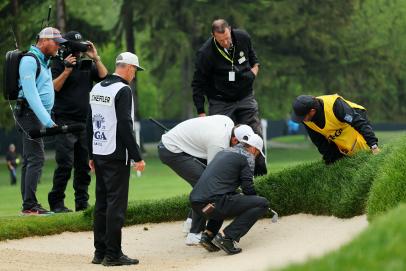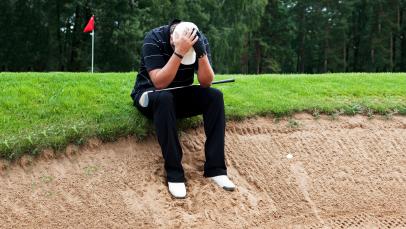Rules Review
Rules of Golf Review: Here's a crafty (but legal) way to take relief and get your ball into a much better lie

Icon Sportswire
Not everything in the Rules of Golf should be thought of as a negative or hindrance to your round. In fact, a little research in what you can and can't do will often result in you thinking you just hacked the system.
Today's topic: The double drop.
Smart golfers know that when taking relief from a condition (free relief or penalty relief), the nearest point might put your ball in yet another relief condition. And guess what? You get to drop again, likely even farther away from the crappy lie your ball is currently in. A dreamy scenario might play out something like this:
You slice your ball through the fairway and over a cart path into some fescue on the right side of the hole. The ball is buried and you would need a weed-wacker to extricate it. Fortunately, because you're a right-handed golfer and (logically) intend to play your next shot as a righty, you would have to stand on the cement path to hit out of the fescue. That means you could take free relief (it's called "complete relief" now) from this condition (an immovable obstruction). Assuming the nearest point is on the fairway side of the path, you could drop there and play on without penalty. So you’ve already used the rules to your advantage in a big way.
But wait … there’s more.
Here's where the double-drop comes into play. On the left side of that cart path is a drain, and that drain interferes with your ball, stance or swing when you take cart-path relief. Guess what? You get to drop again. This time, perhaps even closer to the short grass in a pretty tasty lie. So you just went from having to deal with a ball buried in fescue grass to it now being propped up in short rough—all of this without having to take a penalty.
Good stuff, right? And it's perfectly within the rules.
Granted, these situations are unusual, but they do happen. Sami Valimaki got to drop a good distance from where his tee shot came to rest on the 72nd hole of the PGA Tour's Mexico Open at Vidanta in February. Now there was a penalty involved—although in bounds, his ball was unplayable, resting against and undereath a fence that marked the course's boundary. But because a cart path was near the fence, Valimaki was able to play from the rough on the other side of the path (after taking the unplayable drop, he was able to get free relief from the cart path). He even got to drop twice when taking the free relief from the cart path because his first drop was not from knee height. Coincidentally, his second drop came to rest in a much better lie than the first. Again, fortuitous. Despite taking that unplayable lie penalty, he still ended up saving par on the 72nd hole to preserve his second-place finish in the tournament.
The key thing to remember here is that even though it might be obvious that your nearest point of complete relief puts your ball in a situation where you would need relief again, you still have to go through with the measuring and drop procedures. You can't just skip it because you know, eventually, you'll be dropping again in a different place. It takes a little time, for sure, but it's necessary to go through the motions. And sometimes it actually works to your advantage.


